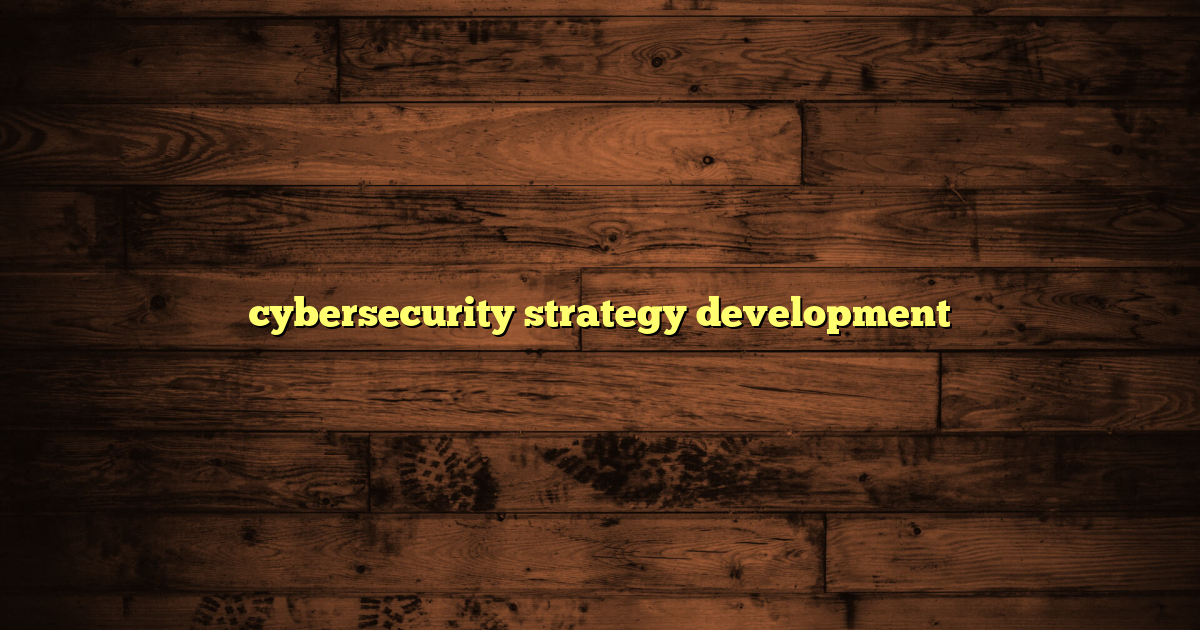cybersecurity strategy development
Table of Contents:
- Understanding What a Cybersecurity Strategy Is
- Step 1: Conduct a Security Risk Assessment
- Step 2: Set Your Security Goals
- Step 3: Evaluate Your Current Technology & Frameworks
- Step 4: Review & Update Security Policies
- Step 5: Create A Risk Management Plan
- Step 6: Develop Implementation Roadmap & Address Human Factors
- Step 7: Implement The Strategy With Project Management Discipline
- Step 8: Continuous Evaluation And Improvement
- Common Pitfalls To Avoid When Developing Your Cybersecurity Strategy
- Why Having A Cybersecurity Strategy Matters More Than Ever
- FAQ
A Comprehensive Guide to Crafting a Cybersecurity Strategy
Did you know that a single data breach can cost a company millions? In today’s increasingly hostile digital environment, a well-defined cybersecurity strategy isn’t just desirable – it’s absolutely essential for any organization wanting to defend its digital assets, data, along with its reputation. It may sound like a difficult, technical undertaking, but constructing an effective cybersecurity strategy can be broken down into clear, actionable steps that align with sound business planning principles. This is your plain-English guide to developing a dependable cybersecurity strategy, drawing from respected and objective sources.
Understanding What a Cybersecurity Strategy Is
At its essence, the cybersecurity strategy is a structured plan. Its purpose is the protection of your IT systems, your networks, and your sensitive data from digital threats. It goes beyond buying the newest security software. It requires a complete understanding of your individual risks, furthermore it creates a constant roadmap for managing those risks effectively.
Step 1: Conduct a Security Risk Assessment
The initial step in developing your cybersecurity strategy involves getting a clear picture of what you’re protecting, moreover from what. This requires answering these questions:
- Identifying Assets – What are the most important parts of your business demanding protection? This can include customer data, financial records, or intellectual property, basically anything of value.
- Classifying Data – All data does not have equal importance and sensitivity. You must classify it accordingly, so you know where to concentrate protections.
- Mapping Assets – Do you understand where those assets reside within your network, or within your physical environment?
- Identifying Threats – What parties may want to attack you? What tactics may they employ? Think hackers or insiders, moreover attacks such as phishing or malware.
The assessment gives you a foundation. It spotlights your vulnerabilities, together with the potential areas of impact.
Step 2: Set Your Security Goals
Now that you know what you need to defend, moreover which threats you face, you must set clear goals. What does success look like? Examples include:
- Reducing phishing incidents by X%
- Making sure all employees (100%) finish security awareness training
- Achieving compliance with regulations like GDPR or HIPAA
Having measurable goals keeps your efforts focused. Additionally, it allows you to track progress.
Step 3: Evaluate Your Current Technology & Frameworks
The next step is assessing your current technology solutions, for example, firewalls or antivirus software. See if they meet today’s requirements.
Along with the evaluation comes selecting an appropriate security framework. The framework serves as a guide on how to manage risk systematically. Popular frameworks include NIST Cybersecurity Framework (used across industries), but ISO/IEC 27001 (the international standard), SOC2 (for service organizations), or HIPAA (specific to healthcare). Selecting a framework helps you structure policies consistently.
Step 4: Review & Update Security Policies
Policies are the rules everyone follows regarding information security. They range from password management protocols to incident response procedures.
Reviewing those policies helps ensure they align with today’s threats, which you identified in your risk assessment, and also with the frameworks you chose. Outdated policies can easily leave gaps that attackers exploit.
Step 5: Create A Risk Management Plan
With risks identified, furthermore policies updated, it’s time to formalize your approach to risk management. This includes:
- Which controls mitigate specific vulnerabilities?
- How can incidents be detected rapidly?
- What procedures are in place for responding when something goes wrong?
The plan should assign responsibilities clearly, so everyone understands their role in maintaining security.
Step 6: Develop Implementation Roadmap & Address Human Factors
A reliable cybersecurity strategy is not all about technology – it depends heavily on people. Your roadmap should include:
- Training programs to teach employees to recognize phishing attempts or social engineering tricks
- Awareness campaigns. They reinforce good habits, for example, locking screens when not in use.
- Resource allocation. That guarantees enough staff time is dedicated to monitoring systems.
In addition to this, you may need infrastructure changes. Add controlled access points that physically secure sensitive areas, as well as digital controls.
Human error is still the biggest cause of breaches – investing here offers a significant payoff.
Step 7: Implement The Strategy With Project Management Discipline
You must put your plans into action with meticulous project management. To ensure the best implementation of your cybersecurity strategy:
- Assign budgets realistically
- Schedule rollouts logically, without disrupting operations
- Track milestones, for example, completing training sessions or deploying new software
Implementation is never instantaneous. Phased carefully, you can ensure adoption sticks.
Step 8: Continuous Evaluation And Improvement
Cybersecurity isn’t something you set up once. It requires continuous vigilance, because new threats appear daily. So:
- Regularly review effectiveness against established metrics.
- Conduct penetration tests.
- When new technologies come into play, update strategies. For example, IoT devices introduce new vulnerabilities.
- When there are any incidents, revise your plan based on lessons learned.
All of those things are part of keeping defenses sharp over time.
Common Pitfalls To Avoid When Developing Your Cybersecurity Strategy
What are some common traps? You can fall into these traps, so be prepared:
- Focusing only on technology, disregarding the human factor
- Ignoring smaller but important assets, assuming “they won’t target us”
- Overlooking compliance requirements until the last minute
- Treating implementation as a one-time event, rather than an ongoing process
Avoid these by balancing people, processes, and technology. Additionally, add a mindset of continuous improvement throughout your organizational culture.
Why Having A Cybersecurity Strategy Matters More Than Ever
Cyberattacks are more sophisticated than before. Ransomware is crippling hospitals and businesses all over the globe. The cost goes beyond financial, reaching into reputation.
Organizations without specific strategies often react after breaches. Preventing them altogether is always better. A well-crafted cybersecurity strategy brings clarity, enabling confident decisions aligned with business priorities. You won’t just chase every new tool promising quick fixes.
In short, developing a good cybersecurity strategy requires understanding what matters. Conduct risk assessments, set measurable goals, choose suitable frameworks, and update policies. In addition, you need to manage risks through plans that address technology and human factors. Implement thoughtfully, with project discipline. Finally, continuously evaluate results to adapt over time.
By following the structured approach, you can build defenses ready for today’s changing threat scene, while supporting long-term growth securely.
FAQ
What if I don’t have a large budget for cybersecurity?
Start with basic, cost-effective measures like employee training, strong passwords, and keeping software updated. Prioritize protecting your most valuable assets first.
How often should I review and update my cybersecurity strategy?
Reviewing and updating regularly, at least annually, is recommended. The frequency may depend on the speed of changes in your industry and technology.
What is the biggest mistake companies make regarding cybersecurity?
The biggest mistake is thinking that cybersecurity is a one-time investment or solely a technical issue. It’s an ongoing process needing both technological and human elements.
Resources & References:
- https://purplesec.us/learn/cybersecurity-strategy/
- https://www.bitsight.com/blog/7-cybersecurity-frameworks-to-reduce-cyber-risk
- https://www.belfercenter.org/research-analysis/cybersecurity-strategy-scorecard
- https://www.frameworksec.com/post/key-components-of-an-effective-cybersecurity-strategy
- https://www.sentinelone.com/cybersecurity-101/cybersecurity/cyber-security-strategy/





